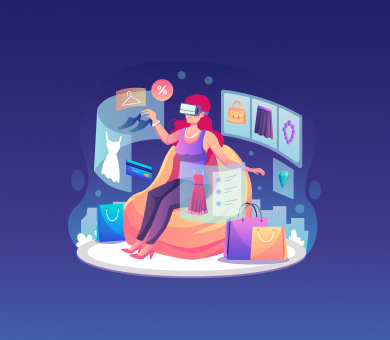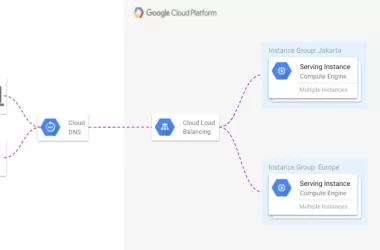The metaverse represents a giant virtual world where real and digital things mix, opening up lots of new possibilities for businesses, especially digital shopping.
It blends elements of gaming, social media, and digital commerce to create a fully immersive space where users can interact with products and services in new and exciting ways.
This article looks at how the metaverse helps online shopping get better, checking out what’s happening now and what might happen later on.
What Is Metaverse and Metaverse Commerce?
The metaverse is a vast online space where people can connect and interact with each other and their surroundings. It uses augmented reality (AR) and virtual reality (VR), and other high-tech tools to create a rich, positive impression.
If you take virtual retailing, the virtual universe can make it more exciting and personal. Customers can try on clothes, test products, and explore virtual stores as if they were actually there.
This makes shopping more fun and personal while also allowing businesses to reach more people around the world. It also creates new ways for companies to promote their brands through virtual events and unique online activities.
Overview of the Integration Trends of E-commerce within Virtual Environments
The integration of e-commerce within virtual settings is changing how businesses connect with customers, offering new and exciting ways to shop and engage. Here are the key trends:
3D Shopping Experience
One of the most significant benefits of metaverse commerce is the enrichment of the customer journey.
Virtual stores can provide customers with interactive and immersive environments where they can explore products in 3D, try on items using virtual avatars, and even participate in live product demonstrations.
These immersive settings bridge the gap between online and offline shopping, offering a more tangible sense of the products.
Personalization and Customization
Personalization is crucial for sales, and virtual settings take this to a new level. By using advanced data analysis and AI, digital commerce platforms can create highly personalized shopping experiences.
Virtual stores can change their layouts and product recommendations based on individual preferences and behaviors. Customers can also customize products in real-time, from clothing to home decor, seeing immediate visual feedback on their choices.
Social Shopping and Community Engagement
The metaverse encourages social shopping, where customers can shop with friends and family in virtual spaces, share opinions, and attend live product launches and events.
This social approach enriches engagement and builds a sense of community around brands.
Virtual environments also support the creation of interest-based groups and forums where users can discuss products, share reviews, and connect with like-minded individuals.
Cross-platform Integration
A major trend in the online world is cross-platform integration that makes sure virtual buying is accessible across multiple devices, including VR headsets, smartphones, tablets, and computers.
This integration guarantees that customers can engage with virtual environments no matter what their device is, making the shopping journey more versatile and inclusive.
Tokenization and Digital Ownership
Tokenization and digital ownership are emerging trends within cyberspace. Brands can create digital twins of physical products, represented as non-fungible tokens (NFTs).
These digital assets can be bought, sold, and traded within the metaverse, offering new revenue streams for businesses and unique ownership opportunities for customers.
Tokenization also enables traceability and authenticity verification, which are crucial in luxury markets.
Opportunities for Brands and Merchants
Virtual environments provide brands and merchants with unique opportunities to engage with their audience.
They can host immersive brand events, such as virtual fashion shows, product launches, and interactive meetings, reaching a global audience without geographical borders.
Brands can also create virtual pop-up stores, offering exclusive products and limited-time offers to attract and keep customers. The use of virtual influencers and branded virtual goods further enhances brand visibility and engagement.
Challenges and Considerations
The metaverse offers excellent opportunities for internet commerce, but it also brings several challenges.
First, developing virtual stores can be expensive, especially for smaller businesses. Besides, creating secure spaces with advanced security mechanisms can add to the overall cost.
Second, not everyone has access to the necessary technology, like VR headsets and high-speed internet, which contributes to a digital divide.
Technical issues, such as slow connections and compatibility problems, can also affect the usability. Plus, not everyone may be comfortable with advanced technologies.
Third, legal and regulatory issues are important, too, as laws on digital ownership and data protection are still being debated.
The fourth problem is linked to protecting intellectual property in the virtual world since digital items can be easily copied. Additionally, ethical concerns, such as inclusivity and the risk of addiction, must be addressed.
Future Outlook and Adoption Trends
In the coming years, online retailing in cyberspace will look bright thanks to better technology and more people becoming interested in it.
With advancements in Web3.0, AR, VR, and AI, virtual spaces will become more open and accessible for everyone to use.
As more young people, especially, start using these digital worlds, businesses will jump in, too, offering special virtual facilities that people can interact with and own using NFTs and blockchain tech.
Overall, the future of retail is all about making sure everyone can join in and that things are fair and square, with rules to keep things in check.
Conclusion
The metaverse is getting ready to change online shopping big time. It’ll make it more fun, personal, and social and give us remarkable new ways to own digital items.
Even though there are challenges, like sorting out privacy and security, the good stuff for businesses and buyers is huge.
As the virtual space keeps growing, it’ll totally change how we shop online, making it more lively, interactive, and connected than ever before.
Are you ready to explore the limitless possibilities of metaverse development for your e-commerce business? Contact SCAND today to discover how we can help you create innovative digital solutions.
The post How Metaverse Benefits E-commerce appeared first on SCAND.








